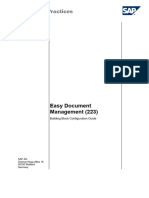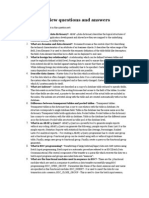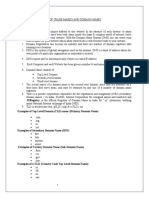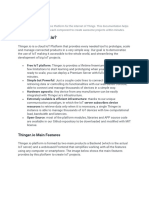CCS Powerpoint Template
CCS Powerpoint Template
Uploaded by
John AudiCopyright:
Available Formats
CCS Powerpoint Template
CCS Powerpoint Template
Uploaded by
John AudiOriginal Title
Copyright
Available Formats
Share this document
Did you find this document useful?
Is this content inappropriate?
Copyright:
Available Formats
CCS Powerpoint Template
CCS Powerpoint Template
Uploaded by
John AudiCopyright:
Available Formats
SYSTEM
ANALYSIS
& DESIGN
METHODS
Instructor: John Audi P. Bato
System Analysis and Design Methods
Objectives
l
Distinguish between internal, external, and turnaround outputs.
l
Differentiate between detailed, summary, and exception reports.
l
Identify several output implementation methods.
l
Differentiate among tabular, zoned, and graphic formats for
presenting information.
l
Distinguish among area, bar, column, pie, line, radar, donut, and
scatter charts and their uses.
l
Describe several general principles that are important to output
design.
l
Design and prototype computer outputs.
System Analysis and Design Methods
System Analysis and Design Methods
Taxonomy for Computer-Generated Outputs
Distribution Internal Output Turnaround Output External Output
Delivery (reporting) (external; then internal) (transactions)
Printer Detailed, summary, or Business transactions Business transactions
exception information printed on business forms printed on business forms
printed on hard-copy that will eventually be that conclude the business
reports for internal returned as input business transactions.
business use. transactions.
Screen Detailed, summary, or Business transactions Business transactions
exception information displayed on monitors in displayed on business forms
displayed on monitors for forms or windows that will that conclude the business
internal business use. also be used to input other transactions.
data to initiate a related
transaction.
Point-of-Sale Information printed or Information printed or Information printed or
Terminals displayed on special- displayed on a special- displayed on special-
purpose terminals purpose terminal for the purpose terminals dedicated
dedicated to specific purpose of initiating a follow- to customers.
internal business up business transaction.
functions. System Analysis and Design Methods
Taxonomy for Computer-Generated Outputs
Distribution Internal Output Turnaround Output (external; External Output
Delivery (reporting) then internal) (transactions)
Multimedia Information transformed into Information transformed into Information transformed
(audio or video) speech for internal users. speech for external users who into speech for external
respond with speech or tone users.
input data.
E-mail Displayed messages Displayed messages intended Displayed messages
related to internal business to initiate business transactions. related to business
information. transactions.
Hyperlinks Web-based links to internal Web-based links incorporated Web-based links
information that is enabled into Web-based input pages to incorporated into Web-
via HTML or XML formats. provide users with access to based transactions.
additional information.
Microfiche Archival of internal Not applicable unless there is Not applicable unless
management reports to an internal need to archive there is an internal need
microfilm that requires turnaround documents. for copies of external
minimal physical storage reports.
space.
System Analysis and Design Methods
l
Internal Outputs
Internal output – an output intended for system owners and system users
within an organization.
l Detailed report – an internal output that presents information with little or no
filtering
l Example: A listing of all customers
l Summary report – an internal output that categorizes information for managers
l
Do not have to wade through details.
l
Increasingly presented in graphical formats using charts
l
Example: A count of customers by region
l Exception report – An internal output that filters data to report exceptions to some
condition or standard.
l
Example: A listing of customers with past due accounts
System Analysis and Design Methods
l
Detailed Report
System Analysis and Design Methods
l
Summary Report
System Analysis and Design Methods
l
Exception Report
System Analysis and Design Methods
l
External Outputs
l
External outputs – an output that leaves the organization
organization.
l
Intended for customers, suppliers, partners, or regulatory agencies.
l
Turnaround documents – an external output that may re-
enter the system as an input.
l Most “bills” and invoices include a stub to be returned by the customer with
payment.
System Analysis and Design Methods
l
External Document
System Analysis and Design Methods
l
Turnaround Document
System Analysis and Design Methods
l
Implementation Methods for Outputs
l
Printed output
l Tabular output presents information in columns.
l Zoned output places text and numbers into designated areas
l
Screen output
l Graphic output is the use of pictorial charts to convey information and demonstrate
trends and relationships that cannot be easily seen in tabular formats.
l
Point-of-sale terminals
l
Multimedia
l
l
Hyperlinks
l
Microfilm or microfiche
System Analysis and Design Methods
l
Chart Types
Line charts show one or more series of data over a period of
time. They are useful for
summarizing and showing data at regular intervals. Each line
represents one series or
category of data.
Area charts are similar to line charts except that the focus is on
the area under the
line. That area is useful for summarizing and showing the
change in data over time.
Each line represents one series or category of data.
Bar charts are useful for comparing series orSystem
categories of data.
Analysis and Design Methods
l
Chart Types (concluded)
Pie charts show the relationship of parts to a whole. They are
useful for summarizing percentages of a whole within a single
series of data. Each slice represents one item in that series of
data.
Donut charts are similar to pie charts except that they can
show multiple series or categories
of data, each as its own concentric ring. Within each ring, a
slice of that ring represents one
item in that series of data.
Radar charts are useful for comparing different aspects of
more than one series or category of data. Each
Systemdata series
Analysis is Methods
and Design
l
Output Design with an Old Style Printer
Spacing Chart
System Analysis and Design Methods
End of Presentation
System Analysis and Design Methods
System Analysis and Design Methods
You might also like
- SSADM StepsDocument32 pagesSSADM StepsRevathi DuraiNo ratings yet
- SAP MDG QuestionsDocument11 pagesSAP MDG Questionsসন্দীপ রায়100% (1)
- Test 6Document8 pagesTest 6Nguyen Hung DucNo ratings yet
- Chapter 15Document33 pagesChapter 15Mpho NkuNo ratings yet
- Ch#9 1 (SE) DFDDocument11 pagesCh#9 1 (SE) DFDfarhanfarooqff0No ratings yet
- Chapter 5 SYSTEMS - DESIGN - User - Interface - Design - OutDocument20 pagesChapter 5 SYSTEMS - DESIGN - User - Interface - Design - OutvancedrandomNo ratings yet
- Lesson 9: Phase 3: System DesignDocument12 pagesLesson 9: Phase 3: System DesignBhrunthashini KarthikesenNo ratings yet
- Sad Comprehensive Notes 114958Document131 pagesSad Comprehensive Notes 114958eolumwaNo ratings yet
- 183 ERP606 BB ConfigGuide EN FRDocument12 pages183 ERP606 BB ConfigGuide EN FRaoufi younesNo ratings yet
- Abap Knowledge-Fwrice, Ale, IdocDocument14 pagesAbap Knowledge-Fwrice, Ale, IdocKrushna Swain100% (1)
- MisDocument12 pagesMis4yk76chvs5No ratings yet
- SAP - Utd - OutgoingDocument12 pagesSAP - Utd - Outgoingpulkovka8687No ratings yet
- Database View - Help View - Projection View - Maintenance ViewDocument13 pagesDatabase View - Help View - Projection View - Maintenance ViewrutulhtiNo ratings yet
- Chap 2-1 Function-Oriented Design StrategyDocument34 pagesChap 2-1 Function-Oriented Design StrategyAnnaNo ratings yet
- HW 20221Document31 pagesHW 20221mayank barsenaNo ratings yet
- Reporting: Feel' Than The 'Real Heavy Stuff'Document3 pagesReporting: Feel' Than The 'Real Heavy Stuff'Manoj KalisettyNo ratings yet
- Data Flow DiagramDocument11 pagesData Flow Diagramsheebakbs5144No ratings yet
- 3440 System Analysis and Design NotesDocument105 pages3440 System Analysis and Design NotesEdwin OdhiamboNo ratings yet
- Nine 02 07 ManagingBPM Its Ply Chain Matrix Francis FinalDocument4 pagesNine 02 07 ManagingBPM Its Ply Chain Matrix Francis Finalvivino007No ratings yet
- Amit PaulDocument3 pagesAmit PaulAbdul RahimNo ratings yet
- Nterprise Esource Lanning: What Is ERP?Document30 pagesNterprise Esource Lanning: What Is ERP?Ankur ChoudharyNo ratings yet
- Chapter 02 Introduction To Transaction Processing.: Presented byDocument46 pagesChapter 02 Introduction To Transaction Processing.: Presented byjelNo ratings yet
- Object Oriented ModelingDocument31 pagesObject Oriented ModelingAfzaal AkhtarNo ratings yet
- B93 BB ConfigGuide en deDocument20 pagesB93 BB ConfigGuide en debhusarepranav25No ratings yet
- 2 Information SystemDocument58 pages2 Information SystemzenrotationNo ratings yet
- BusinessIntelligence 2023Document36 pagesBusinessIntelligence 2023mccreary.michael95No ratings yet
- Reporting 101: Understanding The Why, What, and How of Reporting SolutionsDocument4 pagesReporting 101: Understanding The Why, What, and How of Reporting SolutionsEdward KokNo ratings yet
- Sad Comprehensive NotesDocument132 pagesSad Comprehensive Notesmichaelodhiambo692No ratings yet
- Seminar On Database Management System DesignDocument43 pagesSeminar On Database Management System DesignOzioma Teddy UkwuomaNo ratings yet
- 223 ERP606 BB ConfigGuide EN CNDocument13 pages223 ERP606 BB ConfigGuide EN CNNoSpamNo ratings yet
- Badi Bapi, Idoc, RicefsDocument7 pagesBadi Bapi, Idoc, RicefsUMAKANT MAHAPATRANo ratings yet
- BI Ques AnsDocument51 pagesBI Ques AnsAbid SheikNo ratings yet
- Unit 02-Business ProcessesDocument20 pagesUnit 02-Business Processeshiranya939509No ratings yet
- Objectives For Input DesignDocument4 pagesObjectives For Input Design555bsyadav555No ratings yet
- Software Analysis & Design Tools: Data Flow DiagramDocument12 pagesSoftware Analysis & Design Tools: Data Flow Diagramamitfegade121No ratings yet
- Unit II: Business Reporting and Business Performance ManagementDocument52 pagesUnit II: Business Reporting and Business Performance ManagementVinay JokareNo ratings yet
- Sap Abap Interview Questions and AnswerDocument45 pagesSap Abap Interview Questions and Answersumit sumanNo ratings yet
- Transgrid - IT Governance Framework - 19 Jun 2020 - PUBLICDocument8 pagesTransgrid - IT Governance Framework - 19 Jun 2020 - PUBLICEqbal GubranNo ratings yet
- Lecture (1) REDocument55 pagesLecture (1) REamjaaad996No ratings yet
- Assignment 2 S.A.DDocument9 pagesAssignment 2 S.A.DSeema JunejaNo ratings yet
- PI-PCS Interface PDFDocument111 pagesPI-PCS Interface PDFAlfredo Machado NetoNo ratings yet
- ERP SystemsDocument38 pagesERP SystemsAamir Shehzad50% (2)
- Interview QuestionDocument49 pagesInterview QuestionJoy DeyNo ratings yet
- 100 Abap Questions: ABAP Development FAQ Types of ReportsDocument6 pages100 Abap Questions: ABAP Development FAQ Types of ReportsMani KandanNo ratings yet
- Qa - AbapDocument6 pagesQa - AbapDeepak AgnihotriNo ratings yet
- System Design PageDocument43 pagesSystem Design PageAmitav BiswasNo ratings yet
- 178 Erp606 BPD en CNDocument21 pages178 Erp606 BPD en CNNoSpamNo ratings yet
- Lesson 2 - Internal ControlsDocument30 pagesLesson 2 - Internal ControlsSANDALI FERNANDONo ratings yet
- 197 Erp605 BPD PT BRDocument19 pages197 Erp605 BPD PT BREXTRA CELLNo ratings yet
- ABAP Interview Questions and Answers: by Admin - May 2, 2005Document3 pagesABAP Interview Questions and Answers: by Admin - May 2, 2005Rammohan ReddyNo ratings yet
- Fundamental of Software Engineering: Faculty of Technology Department of Computer Science Debre Tabor UniversityDocument24 pagesFundamental of Software Engineering: Faculty of Technology Department of Computer Science Debre Tabor UniversityBethelhem YetwaleNo ratings yet
- 9 - TPS FRS XBRLDocument82 pages9 - TPS FRS XBRLZooeyNo ratings yet
- Sap BiDocument13 pagesSap BiSurya AnjuNo ratings yet
- Experiment 1Document46 pagesExperiment 1Er NikkiNo ratings yet
- ABAP Interview Questions and AnswersDocument4 pagesABAP Interview Questions and AnswersPrasad ShivaramNo ratings yet
- Production Package SystemDocument26 pagesProduction Package SystemHarichandran KarthikeyanNo ratings yet
- Business Logic ReviewerDocument8 pagesBusiness Logic ReviewerJacob ManaloNo ratings yet
- G Chapter 3 System AnalysisDocument13 pagesG Chapter 3 System AnalysisBaluNo ratings yet
- Analysis and Design of E-Commerce Systems 8Document32 pagesAnalysis and Design of E-Commerce Systems 8hamedskyNo ratings yet
- Computer Systems Design & Related Service Lines World Summary: Market Values & Financials by CountryFrom EverandComputer Systems Design & Related Service Lines World Summary: Market Values & Financials by CountryNo ratings yet
- Slide TemplateDocument2 pagesSlide TemplateJohn AudiNo ratings yet
- Shierwin Alberio - Autorecovery Save of Shierwin Alberio 3Document3 pagesShierwin Alberio - Autorecovery Save of Shierwin Alberio 3John AudiNo ratings yet
- Richard Tee 3Document3 pagesRichard Tee 3John Audi0% (1)
- Gilbert John Baliola GilbertJohnBaliola Activity3 31Document3 pagesGilbert John Baliola GilbertJohnBaliola Activity3 31John AudiNo ratings yet
- Marlonjrm Choa - Marlon Choa Article - 3Document2 pagesMarlonjrm Choa - Marlon Choa Article - 3John AudiNo ratings yet
- Earlyn Kate Grimares Earlynkategrimares Acivity3 26Document4 pagesEarlyn Kate Grimares Earlynkategrimares Acivity3 26John AudiNo ratings yet
- Aicson Sanico Aicson Activity1 4Document1 pageAicson Sanico Aicson Activity1 4John AudiNo ratings yet
- Reyc. Villa Camp A Rey Activity 01 63Document1 pageReyc. Villa Camp A Rey Activity 01 63John AudiNo ratings yet
- Axcelrosed Singson Axcelrosesingson@Activity3 15Document3 pagesAxcelrosed Singson Axcelrosesingson@Activity3 15John AudiNo ratings yet
- Bove Molino - Bovemyidol - 16Document2 pagesBove Molino - Bovemyidol - 16John AudiNo ratings yet
- Jirehjeh A. Bagundol Jirehjehbagundol Activity1 42Document2 pagesJirehjeh A. Bagundol Jirehjehbagundol Activity1 42John AudiNo ratings yet
- Janrey Lapore Janrey Lapore Activity 1 39Document2 pagesJanrey Lapore Janrey Lapore Activity 1 39John AudiNo ratings yet
- Assignment-01 Project Proposal (Scope Document) For Wedding PlannerDocument10 pagesAssignment-01 Project Proposal (Scope Document) For Wedding PlannerMuhammad ArsalanNo ratings yet
- HTML NotesDocument15 pagesHTML NotesTusshar GuravNo ratings yet
- Manzil KatwalDocument2 pagesManzil Katwalmanzil katwalNo ratings yet
- CV Copy 20210423Document2 pagesCV Copy 20210423s.artemakisNo ratings yet
- 1Z0 997 Practice TestDocument9 pages1Z0 997 Practice TestnikiilyNo ratings yet
- SQAT - FMO - FuncReq Spec - v1.6Document110 pagesSQAT - FMO - FuncReq Spec - v1.6nd0906No ratings yet
- The Important Methods of Window Object Are As FollowsDocument5 pagesThe Important Methods of Window Object Are As FollowsMac John Teves PobleteNo ratings yet
- Vijeo Historian V4.40 Installation GuideDocument49 pagesVijeo Historian V4.40 Installation Guidejoy insideoutNo ratings yet
- Oracle 11i Beginner Technical TrainingDocument104 pagesOracle 11i Beginner Technical TrainingFrancisco UvalleNo ratings yet
- 14 Social Media Channels - Quirk Textbook 5Document22 pages14 Social Media Channels - Quirk Textbook 5anh.tranNo ratings yet
- AoPS Forum - Inequality With X, Y, Z Positive Reals and Xyz 1Document2 pagesAoPS Forum - Inequality With X, Y, Z Positive Reals and Xyz 1Khoon Yu TanNo ratings yet
- Fernandez Learning Activity 4Document2 pagesFernandez Learning Activity 4Ashley FernandezNo ratings yet
- Learn How To Get Free Youtube SubscribersDocument3 pagesLearn How To Get Free Youtube SubscribersHardisonMason31No ratings yet
- Law and TechnologyDocument22 pagesLaw and TechnologyWorkaholicNo ratings yet
- HypothesisDocument14 pagesHypothesisAkshay Sharma100% (1)
- Willy Wonka Textured Font 2023 - BehanceDocument7 pagesWilly Wonka Textured Font 2023 - BehanceLateefah LiaoNo ratings yet
- Jiarui Lin PPT WechatDocument14 pagesJiarui Lin PPT Wechatapi-505564601No ratings yet
- BC Unit 5Document14 pagesBC Unit 5d.vigneshvicky2004No ratings yet
- LinkDocument1 pageLinkJefri AndreanNo ratings yet
- Rishabh ResumeDocument1 pageRishabh ResumeSRINIKHITA POLENo ratings yet
- SEO Affiliate Marketing: A Comprehensive GuideDocument18 pagesSEO Affiliate Marketing: A Comprehensive GuideSARAHNo ratings yet
- Simetrix ManualDocument419 pagesSimetrix ManualLuke Austin VargasNo ratings yet
- Pepco - Google SearchDocument1 pagePepco - Google SearchLori CristeaNo ratings yet
- Database Errors Occurred - ORA-00001 - Unique Constraint ViolatedDocument2 pagesDatabase Errors Occurred - ORA-00001 - Unique Constraint ViolatedSunkaraVenkataramanaNo ratings yet
- Data and Cyber Security: The Study of Facebook MetaDocument6 pagesData and Cyber Security: The Study of Facebook MetaInternational Journal of Innovative Science and Research TechnologyNo ratings yet
- What Is Thinger - Io?Document18 pagesWhat Is Thinger - Io?Shishir KumarNo ratings yet
- DataGrid (Grid View) Interview Questions Answers GuideDocument8 pagesDataGrid (Grid View) Interview Questions Answers GuideKapil SharmaNo ratings yet
- 4 Test Cases For Banking ApplicationDocument3 pages4 Test Cases For Banking Applicationnngdf67% (3)
- Vicky Kumar ResumeDocument1 pageVicky Kumar ResumeAswin RonaldoNo ratings yet





































































































